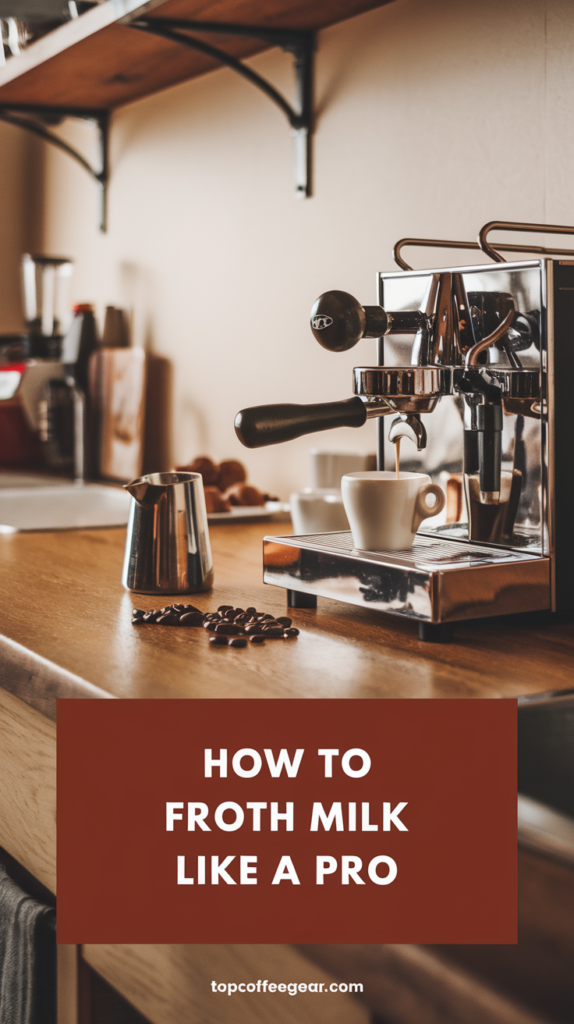This website contains affiliate links. As an Amazon Associate, I earn from qualifying purchases. The content on this website was created with the help of AI.
Learning to froth milk is key for any home barista. It’s needed for latte art and adding a creamy touch to espresso drinks. With an espresso machine, you can get that perfect froth found in coffee shops.
We’ll show you how to froth milk like a pro. This guide covers everything from choosing the right milk to using your espresso machine. We’ll also share tips to avoid common mistakes.
Choosing the Right Milk for Frothing
Choosing the right milk is key to perfect froth. The type of milk affects the froth’s texture, stability, and taste. Whether you like traditional dairy or non-dairy options, each has its own benefits.
Whole Milk vs. Non-Dairy Alternatives
Whole milk is popular for its creamy texture and stable foam. Its high fat content makes the froth richer and more velvety. On the other hand, non-dairy milks like almond, oat, and soy milk offer a plant-based option.
Plant-based milks froth differently due to their protein and fat levels. Oat milk is known for its thick, smooth froth. Almond milk can be tricky to foam, but soy milk’s high protein makes it a good choice for a satisfying froth.
| Milk Type | Frothability | Flavor Profile |
|---|---|---|
| Whole Milk | Excellent | Creamy, Rich |
| Oat Milk | Very Good | Sweet, Smooth |
| Soy Milk | Good | Nutty, Bold |
| Almond Milk | Moderate | Nutty, Light |
Freshness Matters
Fresh milk is crucial for great froth. It has better proteins and fats for a stable foam. Fresh milk also tastes richer, improving your coffee’s flavor.
Always check the milk’s expiration date. Using milk that’s too old can ruin the froth and taste. Fresh milk makes a big difference in your coffee’s quality.
Getting to Know Your Espresso Machine
Mastering espresso starts with knowing your machine’s parts. The steam wand is key. It’s crucial for frothing milk and reaching espresso machine mastery. Learning to control the milk frothing temperature is essential.
Steam Wand Mechanics
The steam wand froths milk, making your drinks cafe-like. Machines from Breville and DeLonghi have different designs. They usually have
- Pannarello wands: Easy to use, great for beginners.
- Traditional steam wands: Baristas love them for control.
- Automatic steam wands: Perfect for easy, consistent frothing.
Temperature Control
Controlling milk temperature is key to espresso machine mastery. The right milk frothing temperature prevents scalding and makes the milk smooth. Aim for 150°F to 155°F. User manuals from Breville and DeLonghi are helpful. You’ll get the hang of it with practice.
| Steam Wand Design | Best For | Control Level |
|---|---|---|
| Pannarello Wands | Beginners | Low |
| Traditional Steam Wands | Professional Baristas | High |
| Automatic Steam Wands | Consistency Seekers | Medium |
The Importance of Milk Temperature
The starting temperature of your milk is key for great froth. Experts say to start with cold milk, between 35°F and 40°F. This makes it easier to control the heat and get the right froth.
When heating milk, watch the temperature closely. Aim for 140°F to 160°F to get a smooth texture. If it gets too hot, the milk can burn, ruining the taste and froth.
Baristas suggest using a thermometer for exact heat. George Howell, a famous barista, says, “The right milk temperature is crucial. It changes the foam’s feel and the coffee’s taste.”
In short, knowing how to heat milk is vital for great froth. This skill helps you make coffee that’s always a pleasure to drink.
| Temperature Range | Effect on Milk |
|---|---|
| 35°F – 40°F | Optimal starting temperature for controlled heating |
| 140°F – 160°F | Ideal temperature range for frothing and texture |
| Over 160°F | Risk of scalding, affects taste and froth quality |
How to Froth Milk Like a Pro Using an Espresso Machine
Learning to froth milk can make your home coffee better. This guide will help you make drinks like a barista at home. We’ll cover the key steps and how to avoid mistakes.

Step-by-Step Frothing Guide
Start by understanding the basics and following each step carefully:
- Pour Cold Milk: Pour cold milk into a metal pitcher until it’s one-third full.
- Position the Steam Wand: Put the steam wand just below the milk’s surface. Hold the pitcher at an angle to swirl the milk.
- Turn On the Steam: Turn on the steam to add air to the milk. You’ll hear a hissing sound. Only a few seconds are needed for this step.
- Submerge the Wand: Submerge the wand a bit deeper, keeping the swirl going. This heats the milk evenly without big bubbles.
- Monitor Temperature: Use a thermometer to check the milk’s temperature. Aim for about 150°F for the best froth.
- Finishing Touch: Turn off the steam, remove the wand, and tap the pitcher to get rid of big bubbles. Swirl gently to mix the foam.
For more on the best espresso machines for frothing, check our guide on top espresso machines for beginners.
Common Mistakes to Avoid
Even with a guide, it’s key to know common mistakes. Here’s what to watch out for and how to avoid them:
- Over-foaming: Too much air makes foamy bubbles. Adjust the wand position to control air intake.
- Incorrect Wand Placement: Wrong wand depth affects froth quality. Find the right spot just below the surface.
- Overheating: Milk over 160°F gets scorched. Always check the temperature carefully.
- Neglecting Fresh Milk: Old or stale milk doesn’t froth well. Always use fresh, cold milk.
By following this guide, you’ll get consistent, high-quality froth. This avoids common mistakes beginners make.
Perfecting Frothing Techniques
Mastering frothing is an art that needs understanding of different techniques. The steam wand technique is key to great froth. Let’s explore the important steps to improve your frothing skills.
Angle and Position of Steam Wand
The steam wand’s angle and position are crucial for the right froth. Keeping the angle steady ensures even steam distribution. This leads to smooth, uniform froth.
- 45-degree angle: Hold the steam wand at a 45-degree angle to the milk. This creates the whirlpool needed for microfoam.
- Submerge the wand: Place the steam wand tip just under the milk’s surface. This is key for mixing air well without big bubbles.
Best Practices for Frothing
Improving your frothing skills means following best practices. Coffee experts recommend these tips:
- Milk pitcher grip: Hold the pitcher firmly but let it move with the steam. A relaxed grip helps control frothing.
- Depth consistency: Keep the steam wand at the same depth. This ensures even milk texture.
- Temperature control: Watch the temperature closely. Milk should be between 150-155°F for the best froth. Too hot can burn the milk and ruin the taste.
For more on mastering milk frothing, check out here for tips and advice from pros.
Espresso Machine Frothing Tips for Beginners
Frothing milk can seem tough, but it’s easy once you know the steps. This guide is perfect for beginners. It will help you improve your frothing skills and feel more confident.

Start with cold milk to froth it better. Use a metal pitcher and fill it about one-third. Put the pitcher under the steam wand, just below the milk’s surface.
- Positioning: Hold the pitcher at an angle to create a whirlpool effect, which helps incorporate air evenly into the milk.
- Starting the Frothing Process: Turn on the steam wand and introduce air by maintaining the wand just below the milk’s surface until the milk volume doubles.
- Texturing the Milk: Once you’ve introduced enough air, lower the wand slightly to heat the milk without adding more air. This smooths out the microfoam, giving it a velvety texture.
Use a thermometer to check the milk’s temperature. It should not go over 150°F to avoid burning. Turn off the steam wand and clean it right away to avoid milk residue.
“Remember, the angle and position of your steam wand are crucial for creating that perfect froth. Practice makes perfect, so don’t be discouraged if it doesn’t turn out right the first time.”
Consistency is Key:Practice frothing often, adjusting the wand’s position and angle as needed. With these steps, you’ll see your skills improve each time.
With these tips, you’ll froth milk with confidence and ease. Keep trying and perfecting your technique. Soon, you’ll be frothing like a pro!
Maintaining and Cleaning Your Steam Wand
Keeping your espresso machine in good shape is crucial. Steam wand maintenance is key to this. Cleaning it right not only makes your froth better but also keeps your machine clean. Following the manufacturer’s advice and some tips from coffee lovers can really help.
Using a damp towel after frothing milk is a great idea. It gets rid of milk residue and stops it from building up. On the other hand, a dry towel can make it harder to clean. For more on this, check out this page.
For a deeper clean, lemon peel or vinegar mixed with hot water works well. You can also use special cleaning products like Cafiza and Puro. Here’s a table that shows some cleaning methods and their benefits:
| Cleaning Method | Benefits | Usage |
|---|---|---|
| Damp Towel | Effective in removing milk residue | After every use |
| Lemon Peel/Vinegar with Hot Water | Natural and effective | Weekly deep cleaning |
| Cafiza/Puro | Thorough cleaning | Monthly or as needed |
Keeping your espresso equipment hygiene up ensures your machine lasts longer. It also makes sure you get the best coffee. By following these steam wand maintenance tips, you’ll keep your machine in great condition and your froth perfect.
Advanced Frothing Tips for Expert-Level Skills
Ready to take your frothing skills to the next level? Mastering advanced techniques is key. Learning to create and shape microfoam and perfecting the milk’s texture are crucial.
Creating Microfoam
Creating microfoam is an art that needs precision and practice. To get the best froth, start by placing the steam wand just below the milk’s surface. Slowly lower the pitcher as the milk grows, keeping a steady whirlpool. This method mixes air and steam for perfect foam.
Consistency and Texture
Getting the milk texture right is vital for all coffee drinks. Aim for a silky, velvety feel that complements the espresso. Adjust the steam wand’s angle and position to control the foam’s thickness. Whether it’s a latte or a cappuccino, even texture is key for a pro finish.
| Drink Type | Milk Texture | Frothing Technique |
|---|---|---|
| Latte | Silky Microfoam | Low Pitcher Position |
| Cappuccino | Frothy Peaks | Higher Pitcher Position |
| Flat White | Thin Microfoam | Slightly Lower Pitcher |
By mastering these advanced techniques, baristas can make their coffee stand out. With practice and improvement, achieving top-notch froth is possible.
Common Challenges and How to Overcome Them
Even the most experienced baristas face problems when frothing milk. Knowing how to tackle these issues can greatly enhance your frothing skills.
- Insufficient Foam: This can happen if the steam wand is not in the right spot or if the milk is too warm. Make sure the wand is just under the surface and the milk is cold.
- Large Bubbles: This means too much air is getting in. To fix it, keep the steam wand close to the milk but make sure it’s fully in the milk.
- Milk Separation: This is usually because the milk is over-steamed or too hot. Use a thermometer to keep the milk between 140°F and 160°F.
These problems can be fixed with attention and practice. Here’s a quick guide to help you troubleshoot:
| Problem | Cause | Solution |
|---|---|---|
| Insufficient Foam | Improper wand positioning, Warm milk | Position wand just beneath the surface, Use cold milk |
| Large Bubbles | Air introduced too quickly | Keep wand tip close to surface, Fully submerge |
| Milk Separation | Over-steaming, Too hot milk | Use a thermometer, Stay within 140°F-160°F |
With these tips, you can easily solve frothing problems. This ensures every cup you make is top-notch.
Conclusion
Mastering milk frothing with an espresso machine is a mix of techniques, understanding your gear, and practice. We’ve covered everything from picking the right milk to keeping your steam wand clean. Each step is designed to help you reach barista-level frothing skills.
We started with choosing milk types and the importance of freshness and temperature. Knowing your espresso machine’s inner workings is key. We also talked about the right frothing techniques and avoiding mistakes.
Keep practicing to get better at frothing milk. This guide has given you the tools to make professional-quality froth. Don’t be afraid to try new things and improve your skills. Soon, you’ll be a pro at frothing milk.

This website contains affiliate links. As an Amazon Associate, I earn from qualifying purchases. The content on this website was created with the help of AI.



